|
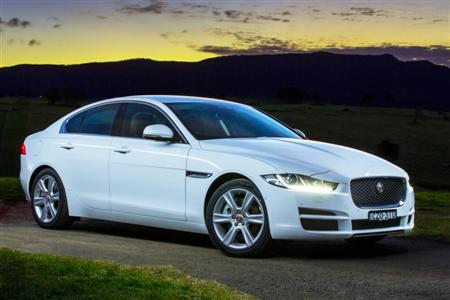 Jaguar XE Prestige
Jaguar XE Prestige
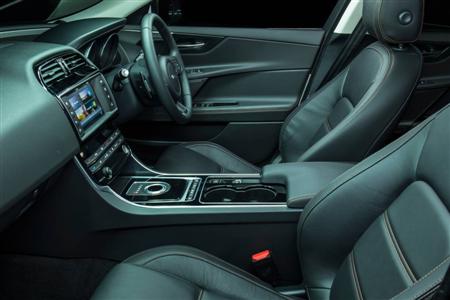 Jaguar XE Prestige
Jaguar XE Prestige
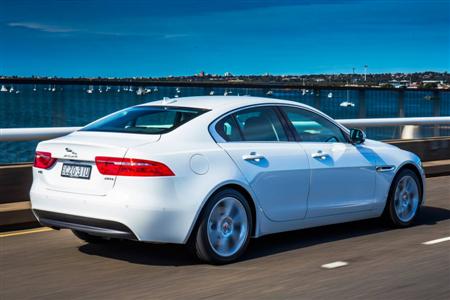 Jaguar XE Prestige
Jaguar XE Prestige
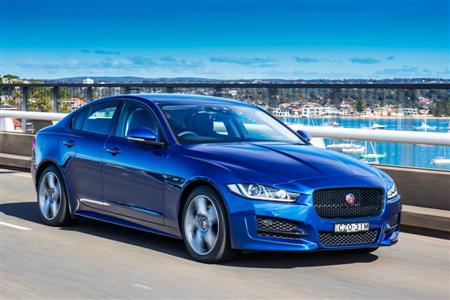 Jaguar XE R Sport
Jaguar XE R Sport
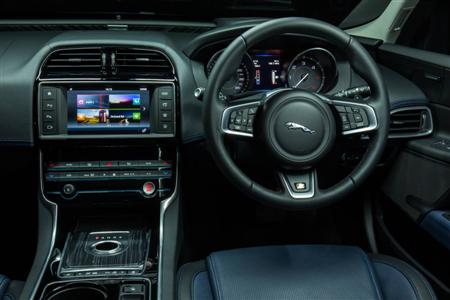 Jaguar XE R Sport
Jaguar XE R Sport
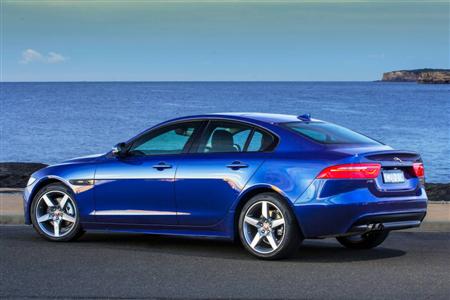 Jaguar XE R Sport
Jaguar XE R Sport
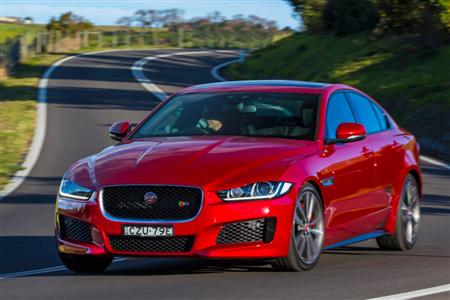 Jaguar XE S
Jaguar XE S
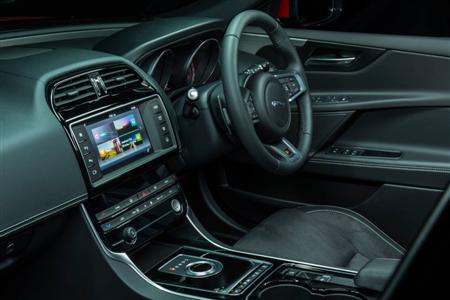 Jaguar XE S
Jaguar XE S
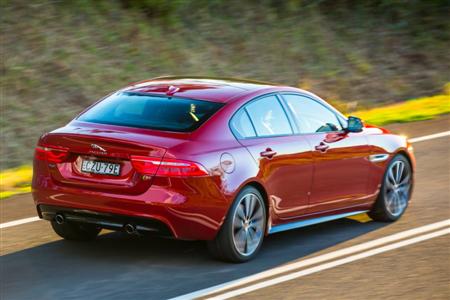 Jaguar XE S
Jaguar XE S
Jaguar XE Pricing*
|
Variant |
Engine |
Price* |
|
Prestige |
20t |
$60,400* |
|
20d |
$62,800* |
|
25t |
$64,900* |
|
R-Sport |
20t |
$64,400* |
|
20d |
$66,800* |
|
25t |
$68,900* |
|
Portfolio |
25t |
$70,400* |
|
S |
V6 |
$104,200* |
|
|
|
Jaguar XE: release imminent
Home >
News >
Jaguar
Related stories:
19th June, 2015 -
Jaguar XE prices announced
1st January, 2015 -
JLR's ‘Follow-Me Ghost Car Navigation’
30th October, 2014 -
Jaguar XE due late 2015
14th September, 2014 -
Jaguar XE 'S' revealed
Recent new car releases ..... here
Upcoming new car releases ..... here
26th August, 2015
- Available from first week in September 2015
- MLP* commences from $60,400*
The most advanced sports saloon that Jaguar has produced, the stunning new XE is instantly recognisable as a Jaguar,
its aluminium skin formed around the fundamental principles of perfect proportions and aerodynamic efficiency.
The new Jaguar XE looks and feels like no other car in its class.
Purity and purpose: Form and function without compromise
Always at the forefront of innovation, Jaguar made the blueprint for the first ever sports saloon with the iconic Mk
II, a car which distilled sports car performance and dynamics into a stylish four-door body. The new XE builds on this
unique heritage, combining Jaguar’s unrivalled expertise in lightweight construction with exquisite lines, sharp radii
and perfectly executed surfaces.
The only car in its class to use an aluminium-intensive monocoque, the XE was developed in parallel with Jaguar’s
lightweight, modular vehicle architecture. Designed from a clean sheet, this architecture – which will form the backbone
of several future Jaguar models – unlocks entirely new design possibilities for the brand.
“Great proportions and a dynamic, edgy feel are at the core of Jaguar design. We wanted to create a strong sense of
movement, and have given the XE a dynamic and purposeful look that is without compromise. Sleek, low, coupe-like exterior
proportions combine with an efficient package that is instantly recognisable as a true Jaguar.” said Ian Callum,
Jaguar Director of Design.
The strongly-sculpted bonnet is a testament to Jaguar’s expertise in working with aluminium, making a taut, muscular
appearance. The very steeply raked windscreen and the rising waistline accentuate the streamlined, almost coupe-like
profile, adding to the sense of movement.
The signature ‘J-Blade’ running lights are another instantly recognisable Jaguar design.
In the rear lights, a horizontal line intersecting a roundel is a styling feature inherited from the iconic Jaguar
E-type.
Smooth progress: Sleek styling, low aerodynamic drag
Jaguar has a rich history of designing stunning, yet aerodynamically efficient cars. The new XE continues this
tradition of uncompromised form and function: its profile has the lowest drag coefficient of any Jaguar yet – Cd 0.26.
This was achieved through a combination of over 1,200 computational fluid dynamics (CFD) simulations and over eight
million hours of processor time.
The body’s low-drag shape is enhanced by features that amplify each improvement made. Innovations include front
bumper ducts which channel laminar airflow over the surface of the front wheels to reduce drag. This is combined with
lightweight under-floor panels running back to the rear silencer, making an almost perfectly smooth surface, also
significantly reducing drag.
Inside story: Spacious, luxurious
Expectations raised by the XE’s beautiful exterior styling are exceeded once inside. The spacious cabin cocoons front
seat occupants with a deep centre console, providing a cockpit-like feel. The 8-inch touchscreen for the new InControl
infotainment system takes 'centre stage' in the sweeping curves of the instrument panel, and Jaguar’s unique rotary
drive selector rises up from the centre console.
The contour-hugging front seats are mounted low, providing a sports-car like driving position with heating and cooling
options and 12-way power adjustment. The rear seats may also be heated and can offer a 40:20:40 split-fold – a first for
Jaguar – and a through-loading feature.
The XE proves that sleek, streamlined styling and interior space need not be mutually exclusive. All occupants enjoy
generous amounts of head and legroom, and the deeply scalloped seatbacks liberate even more space for passengers seated
in the rear of the XE.
Technical fabrics, fine-grain leathers and contrasting twin-needle stitching give the cabin a bespoke quality. Gloss
black, textured aluminium, contemporary wood veneers, and carbon-fibre trim enhance a luxurious, handcrafted feel.
BODY STRUCTURE
Jaguar is more experienced in the use of aluminium construction than any other vehicle manufacturer, allowing the
development of the revolutionary body structure of the new XE. It is the only car in the class built around an aluminium
intensive monocoque.
Light, stiff, safe
Following development of the aluminium XJ in 2003, the XK, the current XJ and the F-Type, Jaguar’s experience is
embodied in the new XE’s aluminium-intensive monocoque. The XE is the most rigid saloon that Jaguar has ever built and no
other vehicle in the mid-size segment contains more aluminium.
“The Jaguar XE body uses over 75% aluminium content, which far exceeds any other car in its class. This gives us a
body structure with unrivalled low weight: it’s light but also immensely strong with extremely high levels of torsional
stiffness and safety without compromising on vehicle design or refinement” said Dr Mark White, Jaguar Chief Technical
Specialist, Lightweight Vehicle Technologies.
The XE is the first model designed using Jaguar’s all-new modular vehicle architecture.
This advanced structure, which will underpin a range of different models in a number of different segments, is
engineered to utilise the most intelligent mix of materials, including aluminium, high-strength steel and magnesium,
providing exceptional manufacturing flexibility.
For the Jaguar XE, satisfying the demanding targets for ride, handling, fuel economy and safety dictated an
aluminium-intensive monocoque. When Jaguar started work on the original aluminium XJ, the luxury saloon’s body comprised
around 70 per cent conventional grades and 30 per cent high-strength alloys respectively. In the new XE, these
proportions have been reversed.
High-strength aluminium alloys, including AC300 and AC600 grades, are also used in areas such as the A-pillars, front
and rear crash structures, and the cant rail. The B-pillars are high-strength aluminium reinforced with ultra-high
strength steel, with a layer of high-density foam between.
All of this makes the passenger compartment exceptionally stiff, preventing intrusions in the event of a vehicle
collision. The new XE has been engineered to meet the most stringent legislative and consumer crash test requirements
worldwide, including US and EuroNCAP.
Pedestrian protection reaches new levels too: the energy absorbing properties of the aluminium bonnet are enhanced by
a deployable hinge system, which makes additional clearance between the underside and stiff structures such as the
powertrain, suspension towers and the bulkhead.
Recycled aluminium alloy: A world-first
Sustainability is another big part of the story at Jaguar Land Rover. The new XE is the first car in the world to use
a high-strength aluminium alloy – RC5754 – made predominantly from recycled material. The product of several years of
research, this grade contains only a small quantity of primary material, essential to achieving the desired mechanical
properties.
Steels, including advanced high-strength and dual-phase steels, are used for parts such as the rear underbody, door
panels and boot lid. These materials satisfy the particular strength, stiffness and geometrical requirements of these
parts and they also contribute to the XE’s ideal weight distribution. Cast magnesium also makes an appearance: this
ultra-light material is used to make the front-end carrier as well as the cross-car beam.
Aerospace-inspired joining technologies
In 2003, replacing spot welds with a combination of self-piercing rivets and structural adhesives – a technique proven
in aircraft production – represented another stepchange in body engineering at Jaguar. These techniques enable highly
optimised joint design with an outstanding combination of strength, stiffness and durability. Another advantage – and one
extremely difficult to realise with welding processes – is compatibility with dissimilar materials.
To prevent any risk of galvanic corrosion between steel and aluminium panels the XE’s monocoque benefits from five
layers of protection between the two materials. The first is a protective coating of zinc on the steel parts. The joints
are filled with structural adhesive and then the body is e-coated. Seam sealer is applied, and then, finally, paint.
|
|
|
At Next Car
we road test cars!
Check these out!
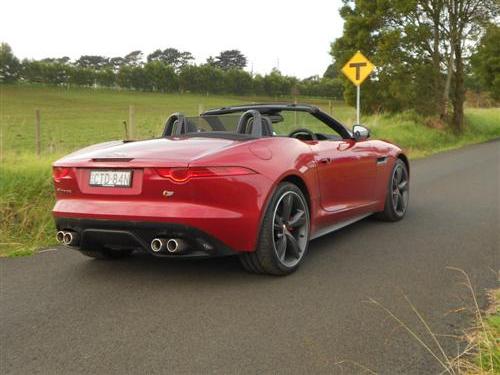
Jaguar F-TYPE V8 S
road test .....
more

Jaguar XKR-S
road test .....
more
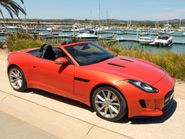
Jaguar F-TYPE S
road test .....
more
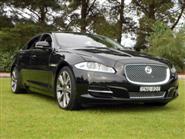
Jaguar XJ 3.0D LWB
road test .....
more
|
|
|
CHASSIS
Jaguar saloons have always been renowned for their matchless combination of sublime ride comfort and outstanding
driving dynamics. The new XE will take this to the next level thanks to double wishbone front suspension, Integral Link
rear suspension and Jaguar’s first application of electric power steering. Development target: be the driver’s car in the
segment.
Agile, responsive, supple
Designing the XE entirely from scratch using a brand new architecture presented the programme team the rare
opportunity to develop a car free of the compromises imposed by legacy platforms and carryover components. As a result
the XE has the most sophisticated chassis of any vehicle in its class and will set the benchmark for ride and handling.
The XE’s light, stiff body structure and longitudinal, rear-drive powertrains provided the perfect starting point for
development. Where most competitors use the simple MacPherson strut front suspension, Jaguar’s vehicle dynamics team
insisted on the superior double wishbone configuration.
“Jaguars have always been renowned for a balance of precise handling and a high-quality ride. The XE is the
culmination of everything the company has learned over the years, providing a combination of supple ride and crisp
handling that is unmatched in this segment.” said Mike Cross, Chief Engineer of Vehicle Integrity, Jaguar.
Camber stiffness was an important consideration. This attribute – the resistance to lateral load when the car is
cornering – is crucial to steering feel. To keep unsprung mass to a minimum, the forged aluminium knuckles are made from
cast blanks using a patented production process. Further weight savings come from the tubular anti-roll bars and springs
made from stiffer, narrower-gauge steel.
The front suspension mounting points enable efficient packaging of the spring and damper assembly – essential to
achieving the low bonnet height fundamental to the XE’s sleek styling and to pedestrian impact protection.
The dampers have been meticulously tuned, giving the sublime ride quality Jaguar cars are famous for and the taut body
control needed for agile handling.
Integral Link: The most sophisticated rear suspension in the segment
Jaguar evaluated conventional multi-link suspensions that are the class standard, but these could not deliver the
dynamic attributes demanded of the new XE.
The solution was Integral Link: a system usually found only in larger, more expensive vehicles and which delivers
benchmark performance. Only Integral Link delivers the combination of lateral and longitudinal stiffness needed for the
XE’s precise handling and smooth, quiet, supple ride.
To keep weight to a minimum, extensive use has been made of aluminium: toe links and upper control arms are forged;
knuckles and lower control arms are hollow cast, saving even more weight.
Electric power steering redefined
Steering response, weight and feel are core elements of Jaguar’s brand DNA, and the ones which probably contribute
most to the ‘50 metre feel’ – the all-important first impression that the vehicle conveys about the way it drives.
Hydraulics have provided power assistance because they deliver the most natural, intuitive system performance.
Electric power steering (EPAS) offers greater tuning potential and greater energy efficiency, but Jaguar’s engineers
have not considered the technology sufficiently mature – until recently.
As a result, the new XE is the first Jaguar to use EPAS and delivers the immediate response and connected feel
expected of a Jaguar sports saloon. All system hardware has been optimised to reduce backlash and friction – the enemy of
natural steering feel – while the control software was honed during an exhaustive tuning phase. The control algorithms
can even account for changes in the ambient temperature, ensuring a consistent steering feel no matter what the
conditions.
As well as functions such as speed-dependent assistance and damping, which varies subtly with the rate with which
steering lock is applied, the steering system also compensates for changes in road camber, keeping the car firmly on
track.
EPAS also cuts the XE’s CO2 emissions by 3 per cent and 2 per cent from petrol and diesel models respectively.
High performance brakes
The dynamic driving character of the new XE is matched by brake system specification. Lightweight sliding callipers
and large discs are used front and rear, with diameters from 316mm to 350mm and 300mm to 325mm respectively.
The ventilated front discs benefit from enhanced cooling thanks to suspension-mounted ducts, which channel air to the
centre of the rotors through apertures in the back plate. The latest-generation electronic brake system controller is
lighter, smaller and more powerful than previous modules and enables myriad functions which improve safety, stability and
dynamics.
Torque Vectoring by braking
One of the most impressive functions on the new Jaguar XE is Torque Vectoring by braking – state-of-the-art technology
that has been proven on the F-TYPE Coupé and is now standard on the new XE.
This high-tech innovation mitigates the onset of understeer by lightly braking individual inner wheels as required to
help keep the car on the optimum line through corners. Intervention is subtle and barely noticed by the driver, who
benefits from more neutral handling, reduced steering effort and, ultimately, a more rewarding driving experience.
POWERTRAIN
The XE is powered by a range of four- and six-cylinder petrol and diesel engines offering a blend of performance,
refinement and efficiency from 111g/km CO2 to 250km/h. All engines benefit from direct injection, variable valve timing
and boosting to deliver clean, quiet combustion and exceptional throttle response. Intelligent stop-start systems and
smart regenerative charging save even more fuel. Power is sent to the rear wheels through a smooth-shifting 8-speed
automatic transmission.
Smooth, refined, efficient
Jaguar is launching the new XE with an equally new engine family – Ingenium. This advanced modular design will provide
petrol and diesel derivatives and was started from a clean-sheet to deliver performance, efficiency and refinement
without compromise. The first Ingenium engine in the Jaguar XE is the 132kW/430Nm 2.0-litre four-cylinder diesel. This
engine achieves a rating of 4.2 litres/100km and 111g/km CO2.
Proven over 2 million miles of testing, Ingenium forms the cornerstone of Jaguar’s future low-CO2 powertrain strategy.
It will also meet the most stringent exhaust emissions legislation worldwide.
“The new generation of Ingenium diesel engines are wholly designed and manufactured in-house at our new engine
plant in Wolverhampton. No opportunity has been missed in ensuring their design is right on the cutting edge of technical
advancement to achieve the highest levels of efficiency, performance and refinement.” said Ron Lee, Group Chief
Powertrain Engineer, Jaguar Cars.
All Ingenium engines, developed from scratch by Jaguar engineers, are based around a deep-skirt aluminium cylinder
block featuring thin-wall, press-fit cast iron liners: these offer the best balance of weight, surface finish, and
robustness.
The engine’s split-cooling system, mapped thermostat, and fully variable mechanical water pump enable standing water
in the block while coolant circulates through the crossflow channels in the cylinder head. So the engine warms up more
quickly, reducing friction and therefore fuel consumption.
Parasitic losses have been cut in other ways too: the electronically-controlled oil pump matches its flow rate
according to engine speed, load and temperature, and switchable piston cooling jets operate only when needed.
Variable valve timing has been a feature on all Jaguar petrol engines for many years, and now the technology is making
its way into the diesel too: the Ingenium units benefit from a cam phaser on the exhaust side. Variable exhaust valve
timing enables more rapid catalyst heating, thereby minimising harmful emissions during the critical warm-up phase.
Fuel is fed to the combustion chambers by an 1,800bar solenoid common rail system. Key attributes are low noise, high
efficiency and excellent mixture formation.
Ingenium diesels are characterised by the rapid build-up of torque from very low engine speeds, enabled by highly
efficient variable geometry turbochargers. Maximum torque is maintained over a wide rev range, ensuring instantaneous
response and strong acceleration whenever the driver demands it.
|
|
|
Next Car's great drives!
Check this out!
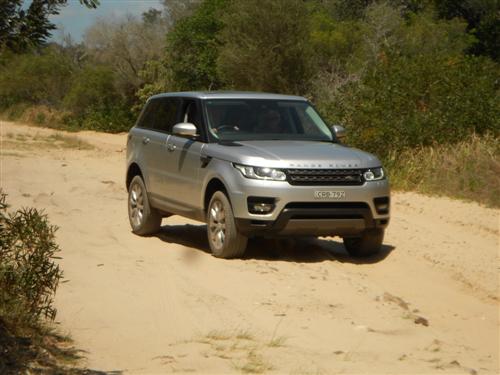
We drive a Range Rover Sport
to enjoy Point Plomer Road
.....
more
|
|
|
Emissions minimised: Clean combustion and advanced after treatment
As well as a sophisticated exhaust gas recirculation system, Jaguar’s powertrain engineers have integrated the most
advanced exhaust gas after treatment technology into the XE: a highly efficient, selective catalytic reduction (SCR)
system ensures that tailpipe nox emissions are below the limits set by Euro 6 regulations.
Four-cylinder petrol engines blend performance with efficiency
The petrol engine range begins with the turbocharged, direct-injection, 2.0-litre four cylinder unit, which made its
debut in the Jaguar XF and XJ saloons. Further refined for the new XE, this lightweight powerplant is available in two
ratings: 147kW/280Nm and 177kW/340Nm.
Weighing only 138kg, these all-aluminium engines feature twin counter-rotating balancer shafts to cancel-out second
order forces, offering the smoothness and power of a naturally aspirated six-cylinder but in a smaller, more efficient
package. An innovative feature is the sheet metal turbine housing integrated into the air-gap insulated exhaust manifold.
As well as saving weight, the assembly’s reduced thermal mass means that the catalyst reaches light-off temperature more
quickly, reducing emissions. The low-inertia turbine wheel delivers outstanding transient response.
V6 supercharged: Power in reserve
For customers demanding superior performance and an exhilarating engine note from idle right up to the redline there’s
the XE S, which shares its supercharged 3.0-litre V6 with the lightweight F-TYPE sports car. This all-aluminium engine is
a modular design with takes its core architecture, including the 90° cylinder bank angle, from Jaguar’s acclaimed 5.0
V8.
A balancer shaft ensures that the V6 matches the larger unit for refinement, while the wide vee provides the packaging
space for the twin-vortex Roots-type supercharger.
Rated at 250kW/450Nm, this engine provides the XE S with exceptional acceleration, driveability and performance:
0-100km/h takes just 5.1 seconds, and top speed is electronically-limited to 250kph.
Optimised eight-speed automatic transmissions
The XE’s aluminium-intensive construction has enabled weight-optimised versions of the benchmark eight-speed ZF 8HP
transmission found in XJ and XF saloons to be offered with all petrol and diesel engines, saving around 10kg.
Always offering the right gear for any condition, the transmission ECU monitors driving styles and adapts shift
patterns to suit. This intelligent control strategy makes the modes chosen in the Jaguar Drive Control system even more
effective. In the high-performance XE S model, the transmission features steering wheel-mounted paddle shifts, giving the
driver full manual control over gear changes for an even more involving experience.
Advanced driver assistance systems
Jaguar has developed a suite of technologies to make driving safer, more relaxing and more enjoyable. From systems
that improve low-speed traction in adverse conditions to smart braking systems which use stereo cameras to scan the road
ahead – the XE is the intelligent choice in the mid-size segment.
Gaining traction: All Surface Progress Control
Making its world debut in the new XE is All Surface Progress Control (ASPC). This unique traction management system,
akin to a low-speed cruise control, will give the XE unrivalled all-weather capability among rear-drive cars in the
segment.
ASPC is ideal for low-grip surfaces such as snow-covered driveways and ungritted winter roads, and even wet grass.
Developed with the input of decades of Jaguar Land Rover experience in off-road traction systems, ASPC can electronically
gain traction with far less drama than the driver can achieve.
The system functions between 3.6km/h and 30km/h and is activated using the cruise control switches on the steering
wheel. Having set the desired speed the driver concentrates on steering – the car takes care of the rest, ensuring smooth
progress without skidding and without the driver touching the pedals.
Laser Head-Up Display: Information right where it’s needed
A first for Jaguar and for the industry, the XE’s laser head-up display (HUD) projects high-contrast colour images
directly in the driver’s line of sight and is smaller and almost a third lighter than existing TFT systems.
The virtual images appear to ‘float’ two metres in front of the driver. Displaying information such as speed,
turn-by-turn navigation instructions, and cruise control settings in this way means that the driver’s eyes remain focused
where they’re needed most: the road ahead.
Greater contrast means greater resistance to image ‘washout’ in very bright sunlight. Another advantage of laser
technology is that the images remain clearly visible should the driver be wearing polarised glasses.
Seeing things clearly: Stereo camera technology
The new Jaguar XE is one of the first vehicles in the segment to feature a stereo camera. This state-of-the-art sensor
provides a 3D view of the road ahead and is at the centre of the autonomous emergency braking (AEB) system.
Mounted in front of the rear-view mirror, the forward-facing stereo camera can detect vehicles up to 100 metres away.
If the algorithms in the AEB control module determine that a collision is likely, the brake system is pre-charged and the
driver receives a visual warning in the instrument cluster and, if fitted, the head-up display. If no action is taken,
full braking force is triggered automatically: the AEB system enables collision avoidance or mitigation at speeds up to
80km/h.
|
|
|

Self-Catering Holiday
Accommodation in
Denmark, WA
..... more
|
|
|
The advanced stereo camera also ‘sees’ the road markings too, and this capability is used by the XE’s lane departure
warning system. If the system determines that the vehicle will unintentionally leave its lane, the driver receives haptic
feedback through the steering wheel rim.
The stereo camera can also help the driver to see more clearly: intelligent control of the headlights enables greater
use of high beam, making night driving safer. By networking the headlight modules to the camera’s image processing
algorithms, the high beam assist function will automatically dip the beams when oncoming traffic is detected.
Always looking ahead: Adaptive Cruise Control
The new XE’s adaptive cruise control (ACC) makes motorway journeys even more comfortable. A long-range 77GHz scanning
radar monitors the road ahead, enabling the car to maintain a pre-set distance from vehicles in front. The ACC system can
also initiate emergency braking if it detects an impending collision.
Keeping watch: Blind Spot Monitoring with Closing Vehicle Sensing
The new Jaguar XE can also be equipped with a system to monitor the area behind the car, making overtaking safer.
Medium-range 24GHz radar sensors detect vehicles approaching fast from behind: a flashing icon in the mirrors alerts the
driver of the potential hazard. Once the vehicle enters the blind spot, the icon is shown as a solid.
Slotting into position: Parking made easy
The effort of trying to park in tight spots has become a thing of the past. The new XE can be specified with two
semi-automated park-assist functions, which do the hard work for you. The ultrasonic sensors measure the space and, if
suitable, will enable the car to steer itself during both parallel and bay parking manoeuvres – the driver only has to
control the brakes and accelerator. An exit-assist function will guide the XE out again. Backing out of parking spaces
can be made even safer with the reverse traffic detection system. The sensors used in the blind spot monitoring system
will detect approaching vehicles which may be unseen by the driver and can trigger an alert.
Infotainment and connectivity
The new XE offers a suite of technologies designed to keep you informed and entertained, making every journey even
more of an experience. Perfectly positioned in the sweep of the fascia, the eight-inch touchscreen is at the centre of
the XE’s all-new InControl infotainment system.
The touchscreen features a clear, intuitive user interface designed to give quick, easy access to all features and
functions. Voice control makes the system even simpler – InControl responds to plain speech commands without the need to
navigate down through menus, allowing drivers to keep their eyes on the road.
“In-car technologies in this ever-more connected and fast-paced world are an integral part of your driving
experience. With the all-new XE we’re introducing an entire suite of cutting-edge driver aids and entertainment systems.
Designed and developed from scratch, they will ensure that every journey you take is simpler, more relaxing, safer, and
effortlessly enjoyable.” said Dr Mike Bell, Jaguar’s Global Connected Car Director.
A feature first developed for the flagship Jaguar XJ, dual-view technology is now available in the XE. This
segment-first innovation enables the touchscreen to display vehicle information for the driver while, at the same time,
front seat passengers can enjoy a movie.
Sound quality: Premium audio from Meridian
For drivers who just want to enjoy the music, the new Jaguar XE brings Meridian audio technology to the segment for
the first time. The latest product of the long-standing partnership between Jaguar and British audio experts Meridian,
the 11-speaker system includes a powerful subwoofer and was developed specifically for the XE. Unique algorithms
guarantee the best possible sound reproduction and tailor the experience to the interior’s acoustics. With such an
advanced music and infotainment system, the Jaguar XE will set a benchmark in its class for high quality driver and
passenger entertainment that will be very difficult to beat.
Australian availability
The Jaguar XE will be available from Australian Jaguar dealerships from early September 2015.
Jaguar XE Pricing*
|
Variant |
Engine |
Price* |
|
Prestige |
20t |
$60,400* |
|
20d |
$62,800* |
|
25t |
$64,900* |
|
R-Sport |
20t |
$64,400* |
|
20d |
$66,800* |
|
25t |
$68,900* |
|
Portfolio |
25t |
$70,400* |
|
S |
V6 |
$104,200* |
NOTE:
* Manufacturer's List Price (MLP) excludes dealer delivery fees and the numerous statutory charges (commonly known as
on-road costs). Additionally, please note that all prices, fees and charges are subject to change without notice, as are
the specifications.
E&OE.
|